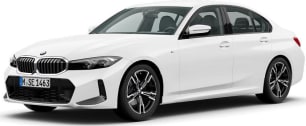Pricing for the two-model launch line-up starts at just under $67,900 before on-road costs for the 320d, rising to $70,990 for the 330i.
That means it remains head-to-head with comparable Merc C-Class models, and other premium mid-size competitors like the Audi A4, Jaguar XE and Lexus IS.
Given many previous Australia-bound 3 Series models have been built in South Africa it's fair to ask where is the BMW 3 Series built, and the answer this time around is Germany.
And the standard features list is long, including 'Adaptive LED headlights' (with 'High-Beam Assistant'), LED fog lights and tail-lights, electrically adjustable and heated exterior mirrors (with electric fold-in function), rain-sensing wipers, three-zone climate control, electrically-adjustable sports front seats (with memory function for driver and front passenger), wireless smartphone charging, 'Aluminium Tetragon' interior trim finishers, 12.3-inch 'BMW Live Cockpit Professional' digital instrument display, 'Navigation System Professional' with 10.25-inch digital touchscreen display also managing a 10-speaker, 205-watt sound system, including a 20GB hard drive and DAB+ digital radio. Apple CarPlay is included.
Also included are 'BMW TeleServices' taking in 'ConnectedDrive'(free use of vehicle apps via 'BMW Online'), real-time traffic info and 'Concierge Services'. The 'BMW Intelligent Personal Assistant' responds to a "Hey BMW' voice command with a range of hands-free functions like nav, calls and texts. We had mixed success in challenging this friendly PA.
The default M Sport trim includes 18-inch 'M Double-spoke' light alloy wheels, BMW Individual high-gloss 'Shadow Line' black treatment on the window frame and air breather surround, the 'M Aerodynamics package' (aero front and rear bumper trims, and side sills), Alcantara/Sensatec (vinyl) upholstery (black with contrast blue stitching), Anthracite BMW Individual headliner, and an M leather steering wheel (with multifunction buttons).
The no-cost 'Luxury Line' treatment swaps in 'Vernasca' leather seats, ash grey-brown interior wood trim, a sport leather steering wheel, the instrument panel trimmed in Sensatec and standard level sport seats for the driver and front passenger.
Step up to the 330i and you can add 19-inch alloys, 'Vernasca' leather upholstery, 'Comfort Access' (keyless entry to all doors), adaptive suspension, M Sport brakes, 'Driving Assistant Professional' (active cruise control with 'Stop&Go' function, front and rear cross-traffic warning, steering and lane control assist, lane keeping assistant with side collision warning, crossroads warning and 'Evasion Aid'), and 'Parking Assistant Plus' ('Parking Assistant' with 'Active Park Distance Control' rear, 'Reversing Assistant', 'Surround View', 'Panorama View', and '3D View').
In terms of colours, 'Alpine White' and black are no-cost, wihle metallic shades - 'Black Saphire', 'Melbourne Red', 'Glacier Silver', 'Mineral White', 'Mineral Grey', 'Mediterranean Blue', 'Sunset Orange', 'Velmont Bronze' (brown), and 'Portimao Blue' add $2000 (rrp). And the 'BMW Individual' metallic shade of 'Dravit Grey' adds $2350.
Lots and lots of fruit without any change to the price. Clearly BMW is determined to bring the 3 Series back to prominence.

